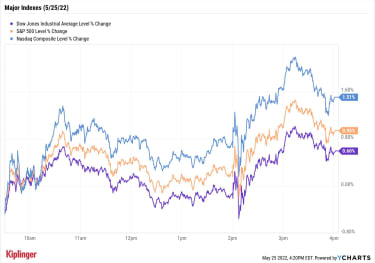U.S. equities enjoyed a broad pop Wednesday following the release of minutes from the Federal Reserve’s most recent meeting, which showed that the central bank’s decisionmakers were willing to be both aggressive but flexible in the face of both inflationary and recessionary pressures.
Much of what the Federal Open Market Committee said in the minutes was largely as expected: Members favor 50-basis-point increases to the Fed’s benchmark interest rate in both its June and July meetings, then could pull back to quarter-point raises in subsequent meetings.
“It’s very clear that bringing down inflation was (and is) the focus at the Fed’s May meeting; Chair Powell has reinforced the need to expeditiously raise rates toward broad estimates of ‘neutral,’ as risks to inflation still tilt to the upside,” says Bob Miller, BlackRock’s head of Americas Fundamental Fixed Income. “We think that after the July meeting, the Fed is likely to become more data-dependent with regard to rate hikes, which essentially means that the policy path after July will depend upon (a) the trajectory of inflation and (b) progress toward correcting the supply/demand imbalances in the labor market.”
While the minutes reinforce what has largely weighed on stocks in 2022 – that the central bank will continue to tighten policy – the Fed’s seeming flexibility helps assuage another growing fear: that of an American recession.
“Elevated risk of a recession is another reason why the Fed could end their rate hike cycle earlier than expected,” says Bill Adams, chief economist for Comerica Bank. “Financial conditions are much tighter than at the start of the year, the economy faces big shocks to disposable income and exports from the Russia-Ukraine war, and housing is starting to turn.”
Sign up for Kiplinger’s FREE Investing Weekly e-letter for stock, ETF and mutual fund recommendations, and other investing advice.
Forceful rebounds by the likes of Tesla (TSLA, +4.9%), Amazon.com (AMZN, +2.6%) and Nvidia (NVDA, +5.1%) – the latter of which was due to report earnings after Wednesday’s close – lifted the beat-up Nasdaq Composite 1.5% to 11,434. The S&P 500 gained 1.0% to 3,978, putting more distance between it and the bear-market threshold. And the Dow Jones Industrial Average closed 0.6% higher to 32,120.
YCharts
Other news in the stock market today:
The small-cap Russell 2000 rocketed 2.0% higher to 1,799.U.S. crude oil futures gained 0.5% to settle at $110.33 per barrel.Gold futures fell 1% to end at $1,846.30 an ounce, snapping a four-day win streak.Bitcoin improved by 1% to $29,627.77. (Bitcoin trades 24 hours a day; prices reported here are as of 4 p.m.)Wendy’s (WEN) jumped 9.8% after Trian Fund Management – an asset management firm founded by billionaire investor Nelson Peltz – said that it had advised the fast food chain’s board of directors that it plans to “explore and evaluate” strategic options, including a potential buyout, as a means of boosting shareholder value. Trian is WEN’s biggest stakeholder, owning 25.3 million shares, or 11.8% of the company, according to S&P Global Capital Intelligence. Peltz, meanwhile, has a 4.7% stake in Wendy’s. “We are unsurprised by Peltz’s appetite, but would not hastily give WEN away,” says Wedbush analyst Nick Setyan, who maintained an Outperform (Buy) rating on the stock and kept Wendy’s on the Wedbush Best Ideas List.It was another big day for retail earnings, with Dick’s Sporting Goods (DKS) stock particularly volatile after its results. Shares were down by 11% at one point after the athletic apparel retailer cut its full-year outlook (now expecting earnings per share to arrive between $9.15 and $11.70, down from $11.70 to $13.10; and for same-store sales to be 2%-4% lower vs. flat) amid sizzling inflation and ongoing supply-chain challenges. However, DKS ended the day up 9.7% after CEO Lauren Hobart said the guidance reflected management being “appropriately cautious,” and that the company’s fundamentals remain strong. Indeed, DKS reported higher-than-expected earnings and revenue in its first quarter ($2.85 per share, $2.7 billion actual vs. $2.48 per share, $2.59 billion estimate). “We still believe the company is well positioned over the next few years to take market share and return capital to shareholders through dividends (now yielding roughly 3.0%) and share repurchases,” says CFRA Research analyst Zachary Warring, who kept a Buy rating on the retail stock.Healthcare: A Steady Helping HandIs this latest upturn for real or just a headfake? That remains to be seen, but the overall outlook is hardly positive from here.
Strategists are fairly split among whether the U.S. falls into a recession – and if it does, whether that recession will hit in 2022, 2023 or even 2024. But even those who expect America to avoid an economic decline don’t see a rosy short-term path. For instance, Jeffrey Roach, chief economist for LPL Financial, says that while “the U.S. will likely escape recession this year, [it will] only grow at a modest clip as we expect inflation to start taking a bigger toll on consumer spending.”
Again: Upside largely seems to lie with those stocks that can pass the buck on to consumers. Savita Subramanian, head of equity and quantitative strategy at BofA Securities, views that as a core trait of healthcare stocks, not to mention their overall defensive stance.
“We believe the sector is well-positioned amid looming recession risks,” she says. “Healthcare offers growth, defense, and yield at a reasonable price: GARP (growth at a reasonable price), DARP (defense at a reasonable price), and YARP (yield at a reasonable price).”
As we approach summertime, we’re looking out toward the back half of 2022 – and that includes reviewing each sector for opportunities. Read on as we highlight a dozen healthcare picks that appear to fit this turbulent investing environment.
Kyle Woodley was long AMZN and NVDA as of this writing.
